Ploughing and Cropping of Public Rights of Way
This Page aims to help landowners and farmers who have a public right of way crossing their land. They have a legal responsibility to keep paths open and available at all times. It is important that landowners and farmers know where paths run across their land and follow the guidance in this leaflet. If the guidance is followed, it will help prevent people from wandering off paths and inadvertently damaging crops or worrying livestock.
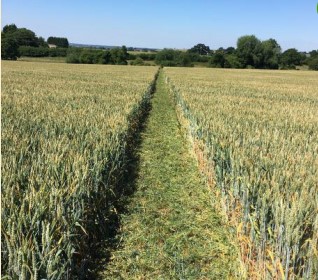
During the growing season
- Where a crop (other than grass) has been sown, the public right of way must be evident on the ground and (unless specified in Staffordshire’s Definitive Statement) meet the minimum widths set out in the tables overleaf.
- As soon as is practical and certainly before the crop reaches a height of 150 mm (6”), remove it from the path, ensuring it remains clear to its minimum width.
- If a crop grows on a path, reinstate the path so that it remains apparent on the ground and is easy to follow. If using a spray, please consider path users and their animals (dogs and horses).
- In the case of tall crops, such as oil seed rape and maize, the potential for crop ‘fall in’ should be taken into account and the minimum width should still be adhered to. In view of this, it is likely that the path will need to be reinstated at a greater width.
- Any side growth from hedges or over hanging trees should be kept clear of field edge paths.
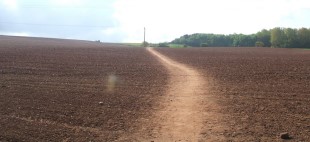
Before and following ploughing
- It is illegal to plough a field edge path.
- Avoid ploughing cross field paths if you can reasonably do so.
- Within 14 days of ploughing, a path must be made good, having a firm level surface and marked on the ground to at least the minimum width.
- It is good practice to reinstate a path before leaving the field.
Further cultivation
- If, after the expiry of the 14-day period following ploughing, further cultivation is necessary, such as harrowing or drilling, a path must be reinstated within 24 hours.
- Upon application, the Council can grant an extension to this period, not exceeding 28 days.
Enforcement powers
Legislation places a duty on Staffordshire County Council to ensure rights of way remain open and available for the public to use and enjoy. The Council may use its powers to take the necessary action to ensure compliance, which may include entering private land in order to reinstate a path. All reasonable costs associated with this will be charged to the landowner or tenant. The Rural Payments Agency may also be informed, which can affect payments made under the Basic Payment Scheme.
Quick Reference Guide - Cross Field Paths
| | Footpath | Bridleway | Byway open to all traffic |
|---|
| Can I plough a cross field path? |
Yes |
Yes |
No |
|---|
| How long do I have to reinstate a ploughed path?* |
14 Days |
14 Days |
N/A |
|---|
| How wide should a cross field path be?** |
1 Metre Minimum |
2 Metre Minimum |
3 Metre Minimum |
|---|
* Within 14 days of ploughing, a path must be reinstated with a firm level surface and be marked on the ground to at least the minimum width
** Unless specified in the Definitive Statement
Quick Reference Guide - Field Edge Paths / Headland
| | Footpath | Bridleway | Byway open to all traffic |
|---|
| Can I plough a field edge path? |
No |
No |
No |
|---|
| How wide should a field edge path be?* |
1.5 Metre Minimum |
3 Metre Minimum |
3 Metre Minimum |
|---|
*Unless specified in the Definitive Statement
Further guidance on the correct method of ploughing and cropping
Below are some example images highlighting the Do's and Dont's of cropping and ploughing near Public Rights of Way.
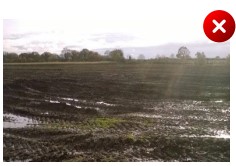
Not acceptable
No effort has been made to reinstate the line, width or surface of the path.
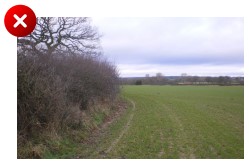
Not acceptable
Although evident on the ground the field path is not wide enough.
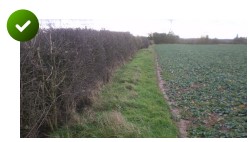
A good example
A field edge path should never be cultivated.
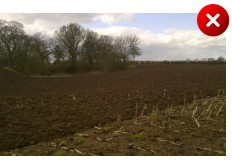
Not acceptable
It is not sufficient to reinstate the line of a path without ensuring the surface is compact, firm and has the correct width.
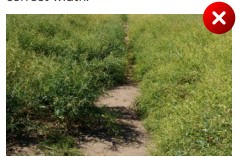
Not acceptable
Although a path is partially clear and apparent on the ground, it has not been reinstated to its correct width.
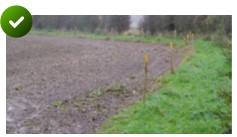
A good example
The width of the field edge path has been marked out using canes to prevent accidental cultivation.
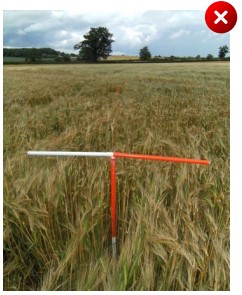
Not acceptable
The crop should be removed immediately as its growth is obscuring the line and width of the path. This path has now become impassable.
Further information
Staffordshire County Council’s Rights of Way Team is here to help resolve any public rights of way issues landowners or farmers have.
Useful information and guidance, including Staffordshire’s Definitive Map and Statement can be found in the rights of way section of our website.
For anything else, please email: rightsofway@staffordshire.gov.uk
Please note the Health and Safety Executive (www.hse.gov.uk) provides advice to farmers, landowners and other livestock keepers whose land is crossed by a public right of way.
This page is available to download as a printable PDF below: